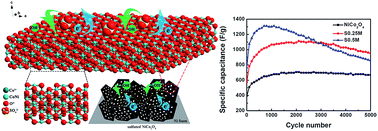Boosting supercapacitive performance of ultrathin mesoporous NiCo2O4 nanosheet arrays by surface sulfation†
Abstract
Surface functionalization is as an effective way to modulate the electrochemical or photoelectrochemical properties of nanomaterials. Sulfated ultrathin mesoporous NiCo2O4 nanosheet arrays are fabricated based on a convenient galvanic displacement process, exhibiting stimulated chemical reactivity and boosted supercapacitive performance. This method not only realizes synchronization of synthesis and surface functionalization but also readily tailors the functionalizing degree of the sulfate-ion and surface reactivity of NiCo2O4 through adjusting the addition amount of the sulfur source. Moderately sulfated NiCo2O4 exhibits a capacitance activation in the first 2100 cycles and achieves the highest specific capacitance of up to 1113 F g−1, an increase of 57% over that of pristine NiCo2O4 during 5000 cycling tests at a high current density of 5 A g−1. Additionally, the sample displays an outstanding cycling performance with 166% capacitance retention. On the basis of structural characterization and surface chemical analysis, this research puts forward a scientific explanation for significantly boosting the electrochemical performance by surface sulfation. In addition, we present a facile route for fabricating sulfated metal oxides without post-processing for energy conversion and storage fields.



 Please wait while we load your content...
Please wait while we load your content...